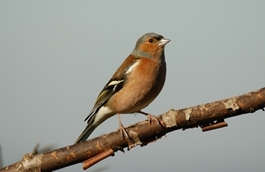The fourth Big Farmland Bird Count is taking place from 3rd – 12th February 2017. If you want to take part, all you need to do is spend about 30 minutes recording the species and number of birds seen on one area of the farm. 
Farmers, gamekeepers and landowners are crucial in the survival and protection of many farmland bird species. However, several of these birds are in decline and efforts to monitor their numbers varies across the country. This is your chance to find out what you have on your farm. This year is even easier. You can use an exciting new online tool to make it quicker for you to record your count and will enable you to plot trends and compare your farm with others in your region.
To take part:
· Visit www.gwct.org.uk/bfbc download a count sheet
· Count the birds on your farm
· Submit your results online
Jim Egan, Head of Development & Advisory at the GWCT explains; “Anyone who works on and cares for the land is vital in helping to ensure the future survival of many of the country’s most cherished farmland bird species. Get out and enjoy the birds on your farm and give us the opportunity to shout about the great work you’re doing!”
Last year 130 different species were recorded, from fieldfare, which migrate from Scandinavia, and long-time resident, the yellowhammer. Other birds expected to be seen include skylarks, which can be found on most areas of open farmland, corn bunting which prefers open lowland farmland, the yellowhammer which favours winter stubbles, game cover and wild seed mixes. Lapwings were one of the most abundant species last year, as they will live on all types of farmland, but prefer mixed farming systems and extensively managed wet grasslands.
Commenting on the count NFU Vice President Guy Smith said “'Citizen science seems very fashionable nowadays with initiatives such as the RSPB’s Big Garden Birdwatch attracting plenty of media attention. So it's great to see the farming community having its own version in the GWCT Big Farmland Bird Count.”
“I always choose a different spot on my own farm to see what species are attracted by certain locations. In 2015 it was the middle of the marsh, so it was dominated by species such as lapwing, golden plover and brent geese. For last year’s BFBC I stood in the field adjacent to my house with an elm hedge on one side and hawthorn on the other. This year it will be between ten hectares of wheat and ten hectares of over wintered stubble. With the current debate about the future shape of Ag policy many are questioning the farming community’s commitment to conservation. The BFBC is a great opportunity to show we are fully engaged and to remind people of the great work we do such as planting new hedges and sowing wildlife margins - as well as enjoying the results!”
The GWCT has held 20 ID Days across the UK in the two weeks prior to the count, and each day was run by a farmland bird expert. Held on participating farms, these were led by experts from both the GWCT and the RSPB experts.
In conjunction with the GWCT Big Farmland Bird Count, CFE (Campaign for the Farm Environment) will be running a series of events across the country in early 2017 providing advice and guidance on managing the farm for birds. The events will look at CFE Voluntary Measures that support farmland birds, and look at the importance of retaining relevant agri-environment options wherever possible, particularly field margins. These can help birds with the ‘hungry gap’ when food sources are low. Good hedgerow management can also be important for supporting farmland birds. For more information visit http://www.cfeonline.org.uk/events/event-details/?ngageid=80352
GWCT’s Big Farmland Bird Count is generously sponsored by BASF and delivered in partnership with the FWAG Association, LEAF (Linking Environment And Farming), NFU and CLA.